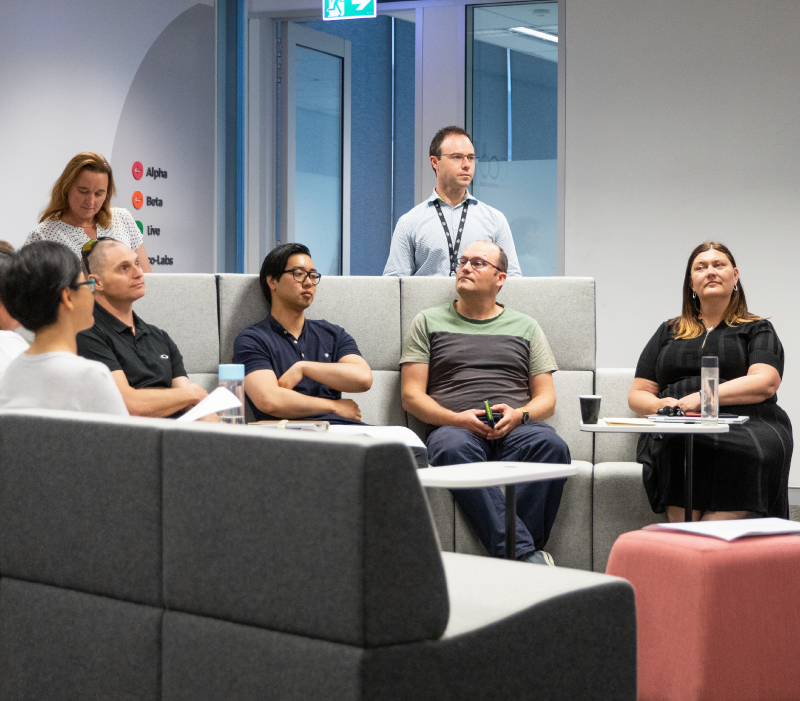-
Co-design the digital service and its accompanying artifacts
Co-design with users
Involve users throughout the Service Design and Delivery Process to make sure their perspectives, needs and feedback are incorporated into the final service. Encourage shared ownership by co-designing accompanying artifacts, such as tutorials and guides, using language that is meaningful to all.
Consider cohort-specific digital inclusion requirements (outlined below)
Tailor the digital service to meet the specific needs of user groups and promote inclusion to make sure support is provided at the appropriate level. Consider how to apply the following cohort specific requirements when designing and delivering digital services.
People with disability
- Use person-first language: Use respectful language in the design and delivery of your digital service. Say ‘people with a disability’, not ‘disabled person’.
- Support independence: Support users to complete their service by providing clear explanations and instructions up front. Advise the user on the documentation they will require at the start of the transaction, so they do not have to get all the way through to understand the requirements.
- Avoid story repetition: Where appropriate, seek consent to share data about user accessibility needs with other channels and services. This avoids them needing to repeat their personal information.
Blind or low vision
- Consider alternative login approaches: Support your users to access alternative login approaches, such as voice identification, instead of the more traditional password entry methods.
- Tag and code headlines: Make the information architecture assimple as possible so information is easy to read and navigate by screen-readers. Tag and code headline types appropriately to support those with vision impairment.
- Make it audible: Offer information in audio formats to support easy access to information. Consider if you can provide audio instructions for how to complete the service to support users to complete their interactions digitally end-to-end.
Deaf or hard of hearing
- Use interpretation technologies: Where available, consider how you can take advantage of best practice and leading technologies for Auslan interpretation (i.e. picture-in-picture solutions).
First Nations Australians
- Respect family structures: Be aware of and respect family structures and the dynamic and complex nature of Aboriginal kinship relations. Collaborate and co-design with Elders and other First Nations Australians throughout the Service design and delivery process.
- Recognise that some information may not exist: Understand that some documents do not exist, due to historical factors, remoteness or lack of available services. Where no legislative barriers exist, consider what alternative documents can be used to support the completion of a service.
- Use visual communication tools: Use visual communication to supplement wordy paragraphs and visual cues. Visual communication should be meaningful from a First Nations perspective.
- Respect privacy: Only request information that is legislatively required and avoid unnecessary additions. Acknowledge that trust may be lacking and be transparent about what the information will be used for and who can access it.
- Use culturally safe language: Consider how chatbots and staffed chat functions can use culturally appropriate language: for example, ‘Are you living with extended mob?’
Persons impacted by family and domestic violence
- Provide visibility of who has access: Consider providing users with a clear and easily accessible list of who can access the service and who will be notified of any changes for example, a change of address. Give users the choice of when and how they receive government communications and make it easy to change, in the event they need to do it quickly.
- Make it easy to remove multiple users: Support survivor-victims to remove multiple users from accessing a shared government service or account. Consider privacy enhancing ways for users to do, so it does not unnecessarily trigger or notify other users.
- Support ‘quick exit’: Consider the use of ‘quick exit’ buttons within your digital service to help re-direct users to other digital pages if they are in an unsafe environment.
- Clearly communicate tasks and actions: Use simple steps and actions to clearly communicate what is required and limit the impacts on survivor-victims. Consider the use of checklists and easy-to-follow formats to avoid decision fatigue and to support the survivor-victims to complete the service.
Neurodiversity
- Keep interfaces and interaction patterns predictable: Be clear on the expectations and next steps by letting users know exactly what will be required of them ahead of time. Consider using consistent designs and patterns to support a seamless transition within the service.
- Make users feel welcome and accepted: Cater to different learning styles and preferences by offering supplementary options to text, such as audio and visual formats and through pictures or images. Allow users to customise their interface by changing colour schemes and making other types of personalisation.
- Simplify the language and service: Simplify language to make it easy to understand and follow without being condescending or minimising the user. Break up tasks into manageable sections and allow forms to be saved so users can return to them later.
- Communicate status: Support users to track the status of their digital services and interactions by communicating status information. Proactively remind users to finish tasks using alerts and notifications if paused part-way through.
Culturally and linguistically diverse communities
- Use visual communication tools: Provide visual ways of communicating as a supplement to wordy paragraphs and visual cues that can be easily interpreted. Create repeatable steps and actions to support users to complete tasks. Consider the use of video conference and other software to help users understand the context through body language.
- Offer in-language options: Identify the most common languages used across your service and offer in language options on the front page of websites so it can be easily changed. Consider how you can offer your guidance materials and tools in other languages to support the user to complete the service.
People with low digital ability
- Clearly communicate tasks and actions: Use simple steps and actions to clearly communicate what is required. Consider using checklists and easy to follow formats to avoid decision fatigue and to support the user to complete the service.
- Support users to move between service channels: Where appropriate, consider how you can support your users to move through your service channels using easy to gather information. For example you may offer downloadable content that they can print out and take into a shopfront to complete the service.
- Apply search engine optimisation: Consider how you can effectively apply search engine optimisation to support users to find information and services easily.
-
Questions for consideration
- Who will use this service?
- How might we address the unique needs and preferences of individuals?
- How will we make sure the service is inclusive and usable for everyone?
- Have we conducted thorough user research to understand diverse user needs?
- How might we demonstrate learnings from research and inform decisions?
-
Guidance and resources
- First Nations Digital Inclusion Plan (2023-26) (niaa.gov.au)
- Disability Strategy | Department of Social Services, Australian Government (dss.gov.au)
- What do we mean by diversity and inclusion? | vic.gov.au (www.vic.gov.au)
- Co-design | vic.gov.au (www.vic.gov.au)
- Research with diverse user groups to improve a product or service | vic.gov.au (www.vic.gov.au)
- Inclusive design | Digital.NSW
- Good Practice Guidelines for Engaging with People with Disability | Disability Gateway
-
-
-
Criterion 1 – Implement a monitoring framework
-
Develop a digital performance monitoring framework to fit your digital service.
-
Your responsibilities
To successfully meet this criterion, agencies need to:
- define clear objectives and goals, based on users’ needs
- identify and choose relevant metrics that align with organisational goals, meet Digital Performance Standard criterion and capture the user experience
- articulate how you will implement the monitoring framework
- develop processes for continuous digital service improvement and share insights.
-
When to apply
Apply Criterion 1 during Discovery of ICT investment planning and as part of your continuous improvement processes in the Live environment.
We recognise agencies have different digital and ICT capabilities. The Digital Performance Standard sets out application approaches based on the maturity of your monitoring framework. Every agency should work towards applying best practice monitoring and reporting methods. At a minimum, your agency should implement a monitoring framework that focuses on providing digital service outcomes based on user experience and feedback.
As best practice, agencies should implement a monitoring framework that embeds user-centric performance monitoring across all your informational and transactional services.
Off -
Questions for consideration
- What are the online needs and expectations of the users?
- How does the framework fit into the strategic landscape?
- What resources are required for successful implementation and maintenance of the monitoring framework?
- How can baseline metrics be established to understand the current state of digital performance and facilitate future comparisons?
-
Guidance and resources
- Digital Performance Standard Guidance
- Digital and ICT Investment Oversight Framework
- Data and Digital Government Strategy
- Australian Government Architecture
- Digital Service Standard
-
-
-
Your responsibilities
To successfully meet this criterion, agencies need to:
- define clear objectives and goals, based on users’ needs
- identify and choose relevant metrics that align with organisational goals, meet Digital Performance Standard criterion and capture the user experience
- articulate how you will implement the monitoring framework
- develop processes for continuous digital service improvement and share insights.
When to apply
Apply Criterion 1 during Discovery of ICT investment planning and as part of your continuous improvement processes in the Live environment.
We recognise agencies have different digital and ICT capabilities. The Digital Performance Standard sets out application approaches based on the maturity of your monitoring framework. Every agency should work towards applying best practice monitoring and reporting methods. At a minimum, your agency should implement a monitoring framework that focuses on providing digital service outcomes based on user experience and feedback.
As best practice, agencies should implement a monitoring framework that embeds user-centric performance monitoring across all your informational and transactional services.
Questions for consideration
- What are the online needs and expectations of the users?
- How does the framework fit into the strategic landscape?
- What resources are required for successful implementation and maintenance of the monitoring framework?
- How can baseline metrics be established to understand the current state of digital performance and facilitate future comparisons?
How to apply criterion 1
-
Digital Performance Standard
The Digital Performance Standard sets the approach to monitor digital performance across government services and support data-driven digital and ICT investment (ICT investment) decisions. Having visibility of digital service performance will support agencies by fostering continuous improvement capabilities within agencies and embedding digital service improvement into their management practices.
-
The criteria
The Digital Performance Standard consists of the following 5 criteria.
Each criterion is accompanied by:
- your responsibilities in meeting it
- when and how it should be applied
- further resources and guidance.
-
-
Downloadable resources
Connect with the digital community
Share, build or learn digital experience and skills with training and events, and collaborate with peers across government.





